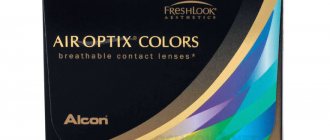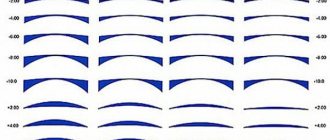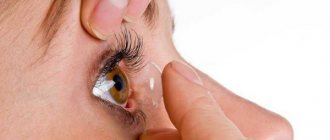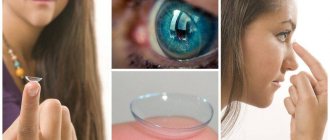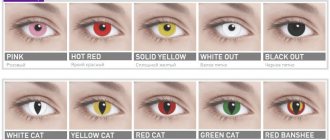- Effective methods to increase profits
- Supplementing glasses with contact lenses
- Working with daily and routine replacement lenses
- Ignoring astigmatism is a mistake
- Notifying patients about new developments and technologies
- Constantly strengthening the loyalty of the customer base
- Daily replacement lenses
- Planned replacement lenses
- Care products
Although the total number of contact lens wearers worldwide remains virtually unchanged from year to year (an outflow of patients is replaced by a roughly equal influx of newcomers), at the scale of an individual practice, it is quite possible to increase profits from contact lens work by attracting new users and supporting those who already make up the optometrist's office client base.
What do contact lenses do?
Contact lenses are small lenses that are in “contact” with your eyes. They are designed to correct refractive error and maintain eye health. The lenses are embedded in the tear film on the cornea.
Modern contact lenses are small lenses that fit onto the cornea of the eye. However, their function is similar to that of ordinary glasses - refraction and focus of light to clearly perceive objects. But because the lenses are embedded in the tear film on the surface of the eye, they move with the eye. And this is one of the advantages of contact lenses over glasses.
Effective methods to increase profits
Supplementing glasses with contact lenses
It is useful to recommend contact lenses to all glasses users as an additional means of vision correction. It's hard to imagine more effective advice to improve the profitability of an optometry practice. This statement is supported by many studies. One of them, conducted by the London Business School, indicates that patients who use glasses and contact lenses generate 80% more profit than those who use only glasses for vision correction. This is explained, among other things, by the fact that patients who alternate glasses with contact lenses are more loyal to their ophthalmologists or optometrists. In addition, according to the results of the study mentioned above, about 60% of contact lens users also purchase glasses from these specialists.
And as practice shows, patients appreciate the advice of professional opticians who recommend using the convenience of combining glasses with lenses. Yes, these days the fashion industry has turned glasses into a stylish accessory that no one is going to be ashamed of anymore. But even in this case, in the life of any modern person there are many situations in which glasses are not the most convenient or suitable means of vision correction. For example, when wearing contact lenses, you can enjoy freedom in choosing active types of recreation, there are no visual or physical restrictions during sports, and you have the opportunity not to wear glasses to work or a party if they do not quite match your outfit or mood.
Working with daily and routine replacement lenses
Numerous studies have confirmed that adherence to lens replacement and care recommendations is higher among patients using these lens replacement regimens. According to the results of one of these studies, 48% of users wear bi-weekly lenses, and 72% wear monthly lenses.
World statistics (for 2020) for the selection of soft contact lenses (SCLs) are generally consistent with this: the share of scheduled replacement lenses worldwide is 51% (in Russia - 46%), and daily replacement SCLs - 32% (in Russia - 13%). In third place is the share of selection of lenses for frequent scheduled replacement: 13% worldwide (in Russia – 31%). Therefore, if in the selection of lenses to focus on products that are less associated with the practice of over-wearing, which is detrimental to eye health, this will benefit both patients and the optical store, because as a result it will be able to sell a larger number of lenses.
Ignoring astigmatism is a mistake
It has been noted that even patients with low degrees of astigmatism (–1.00 D or less) often begin to see noticeably better if they are selected with toric lenses instead of spherical lenses. For optometric practice, the benefits of working with SCLs of complex design are obvious: a higher degree of loyalty to it from patients with astigmatism, who make up a significant proportion of contact lens users at all times; an opportunity to stand out from competitors, most of whom often resort to spherical lenses even in cases where they cannot achieve the desired result - high visual acuity and contrast. However, contact lenses with an aspheric back surface design can compensate for minor astigmatism (up to 0.75 D) in a patient without the use of torics, but with the use of a spherical equivalent.
Notifying patients about new developments and technologies
Technologically, the contact lens industry is developing quite quickly. Hardly a year goes by without some new materials and designs appearing that make wearing lenses even more comfortable, vision clearer, and adaptation to them less difficult. Many regular lens wearers are looking to improve their lens wearing experience and are therefore willing to spend extra money to do so.
But there is also a category of patients who are accustomed to wearing only glasses for a long time and have never used contact lenses, or have tried to wear lenses in the past, but were not satisfied with the result due to discomfort or other reasons. They likely know little about the technological advancements that have made modern contact lenses effective, comfortable, and easy to use. It would be especially useful for such patients to learn about new products.
And even if someone, as it seems from the outside, is quite satisfied with their current lenses, they should not wait until they have problems with them. After all, now you can improve his feelings by offering him some suitable new product.
Constantly strengthening the loyalty of the customer base
Patient loyalty to a particular optometric practice can be strengthened if the practitioner strives to make “happy” contact lens wearers even happier. In this regard, he can be helped by competent recommendations regarding care products, the use of which could contribute to the long-term safe and comfortable wearing of contact lenses by patients.
Customer loyalty can also be increased by sending reminders for annual eye exams and contact lens prescription renewals. This is relevant due to the fact that in reality, patients visit their specialists approximately once every 18 months. It is also useful for an ophthalmologist or optometrist to strive to sell clients a year's supply of contact lenses, which will not only reduce the cost of an individual lens, but also deter patients from purchasing another pair of contact lenses from third-party offline or online sellers. It has also been noted that those who purchase an annual supply of lenses are much less likely to wear them out, which benefits eye health.
Types of contact lenses
Contact lenses are different. They are available in various forms and are designed for various purposes. They differ in modality, or in other words, the frequency of their replacement, for example, replacement every day, every two weeks, every month, etc. They also differ depending on what refractive error is being corrected, for example, contact lenses to correct astigmatism, myopia or farsightedness and other disorders.
Contact lenses have different optical powers, or “diopters.” If you wear contact lenses, read the information on the box or prescription. You will see a plus or minus sign in front of the number. Omitting numerous details, these marks indicate the shape of the lenses. Different shapes correct different vision problems.
Toric lenses, which have a thicker bottom part, correct astigmatism. Spherical lenses, which are uniform in all directions, correct myopia and farsightedness. There are also contact lenses for monovision correction, bifocal and multifocal lenses.
"KonKor" (Vologda)
It is a leader in the production of domestic contact lenses. The work uses imported raw materials (British and American polymers of the highest quality), optical products are machined on high-precision equipment (USA). The ConCor line includes lenses for the correction of several types of vision impairments.
Clear corrective contact lenses
1. Rigid gas-permeable models for the correction of astigmatism and presbyopia, as well as orthokeratological night models for patients with a high degree of myopia. The polymers used in the development of this optics have a high oxygen transmission capacity and hold their shape well. 2. Soft lenses of toric design for astigmatists. They have a spherocylindrical shape and two optical zones. 3. Keratoconus models. Keratoconus is a deformation of the cornea, due to which the visual system begins to malfunction. The specially developed design helps restore visual acuity and quality.
All products are made only to order according to the patient’s individual parameters, and the refractive range ranges from +30 to – 30 diopters.
Such values are very rare among contact lenses, so ConCor is a real salvation for users with severe visual impairments.
Transparent lenses Concor Contaflex 67 and Concor (LB38T) Colored
Colors Aqua and Violet
Painted models
This type of optics is available in four categories. Lenses are also made to order and can have diopters in the same range. You can order “zero” optical products, that is, use them only for decorative purposes (to change eye color):
- tint models will give the eyes a brighter color, without covering the natural one;
- iridescent lenses have a pattern that imitates the natural pattern of the iris, making them look completely natural;
- iridescent Colors can cover the darkest eyes. The palette includes more than 30 shades;
- cosmetic optical products are designed to conceal congenital eye defects or those resulting from injury.
Domestic optics have quarterly and traditional wearing modes.
The lenses are produced in a glass bottle in the amount of one piece. The production time for a pair is 30-40 days. In addition to Russia, products are also available for purchase in the CIS countries.
History of contact lenses
The concept of contact lenses has been around for much longer than many people realize.
Along with other modern devices, Leonardo da Vinci envisioned the concept of contact lenses in 1508. In 1636, René Descartes sketched a design for contact lenses. Later in 1801, a scientist named Thomas Young became the first to wear contact lenses, which were then held in place by wax!
Yes, improvements in the comfort of contact lenses have been going on for a long time.
Soft contact lenses
In 1971, soft contact lenses were officially introduced to the world, ushering in a new era after hard contact lenses.
Daily contact lenses
The next major breakthrough in contact lens technology was the release of the first disposable contact lenses in 1988. Eight years later, in 1996, daily contact lenses were introduced.
Silicone hydrogel contact lenses
We now have silicone hydrogel contact lenses that provide greater comfort and can be worn for longer periods of time than their predecessors.
Colored contact lenses
Have you ever wished your eyes were a different or richer color? Now everything is in your hands, even if you do not require vision correction.
Cosmetic contact lenses can enhance and even change the color of your eyes. This also includes lenses with zero optical power. (Read more about cosmetic contact lenses). There are even black contact lenses that match your Halloween costume. Since contact lenses are a medical product, you should consult your eye doctor before using colored contact lenses.
No matter what type of vision correction you need, we have contact lenses to meet your needs.
What is the next stage in the development of contact lenses? Keep following the news!
How to choose lenses if you work at a computer all day
People who work at a computer for 8-10 hours a day often have sore eyes in the evening: they feel tired, dry and gritty in the eyes, making it more difficult to focus. If you choose the right lenses and change your work environment a little, your eyes will feel much better by the end of the day. We'll tell you what happens to the eyes of those who work at a computer, and how to take care of their vision in such conditions.
Working in front of a computer screen causes “computer syndrome”
Symptoms that occur when working at a computer for a long time are collectively called “computer vision syndrome.”
Its development is provoked by:
- screen flickering and glare;
- rare blinking in front of the screen - 2-3 times per minute (normally we blink 18 times per minute);
- focusing vision on a close object (computer screen) - the muscles responsible for visual acuity when looking at objects at different distances are in a spasm state for a long time, eventually losing the ability to relax. Because of this, a person sees objects in the distance worse.
As a result, eye strain occurs, which is expressed by fatigue, a feeling of sand, dryness, pain around the eye socket, double vision, and headaches. If you do not take measures to relieve the load for a long time, these symptoms intensify and your health worsens. Therefore, for those who work at a computer, special lenses are recommended that protect their eyes from dryness and screen flickering.
For computer work - silicone hydrogel lenses or hypergel lenses53
When working at a computer, it is important that your eyes do not dry out.
To do this, it is necessary that the lenses retain moisture well and “breathe”. Silicone hydrogel lenses and hypergel lenses work best for this. Silicone hydrogel lenses
Silicone hydrogel lenses contain a moisturizing component, most often polyvinylpyrrolidone. It has the ability to attract and retain moisture. Thanks to this, the lens is embedded in the tear film of the eye.
The advanced aspherical lens front surface design reduces image blur and eliminates haze and ghosting around light sources—especially at night.48 The aspherical rear surface improves lens fit by smoothly changing the radius of curvature, and a thin edge helps ensure you don't feel the lens even towards the end day.
As a result, the eyes do not get tired, do not turn red, and the patient does not experience burning or discomfort. The lens is easily removed. Bausch+Lomb ULTRA silicone hydrogel lenses are designed specifically for long-term use with digital devices - they transmit about 98% of oxygen and retain, on average, 95% of moisture, even after 16 hours of wear. The eyes are moisturized, the mucous membranes do not dry out.65 Biotrue ® ONEday lenses made of hypergel 53
To date, the only lenses made from hypergel are the Biotrue ONEday daily lenses. They have a moisture content similar to that of the cornea of our eye - 78%.52 They transmit 93% of oxygen - this is enough for comfortable wearing when working at a computer. The lenses are thin and cannot be felt on the eyes. The outer surface imitates the action of the tear film, which prevents the lens from drying out, which means it maintains its shape and ensures clarity of vision.53 They also contain polyvinylpyrrolidone, which additionally moisturizes the surface of the lenses. If dryness and discomfort occur, use special drops - tear substitutes. Choose drops based on your doctor's advice, but make sure they are approved for use when wearing contact lenses. If you are just starting to use lenses or are switching from one lens to another, then tear substitutes such as Artelak® Splash will help you adapt to them. To care for routine replacement lenses, use universal solutions Biotrue, ReNu MultiPlus or ReNu MPS.
Other ways to protect your eyes when working on a computer
Use additional methods to help preserve your vision and avoid the negative effects of computer screens on your eyes.
Organize your workspace correctly
The monitor should be stationary, its upper edge should be better positioned at eye level or 10 cm lower. The “angle of view” (the angle between the lines connecting the center of the monitor with the eye and the horizontal) should be 15 - 30°. In this position, the area of the ocular surface that comes into contact with air and from which moisture evaporates is minimal.
The correct position of the monitor reduces the evaporation of moisture from the mucous membrane and makes work comfortable
The distance to the monitor depends on the screen diagonal, but not less than 50 cm - as recommended by SanPiN 2.2.2.542-96.
Monitor the level of humidity in the room and drink water
To avoid drying out your eyes, monitor the humidity in the room. The optimal humidity for rooms in the cold period is 30 - 45%, in the warm period - 30 - 60% (according to GOST 30494-2011). If values are below normal, use humidifiers.
Drink enough water so that the glands can produce the necessary amount of tear fluid.
Everyone's need for water is different and depends on body weight, physical activity and other parameters. Do eye exercises and visit an ophthalmologist.
Every 20 minutes of work, take a short rest of at least 20 seconds, and a full rest, performing eye exercises, after every hour of work.
Closing your eyes, looking into the distance, rolling your eyeballs and other exercises will help your eyes relax. We talked in detail about eye gymnastics in a separate article. Visit your ophthalmologist at least 2 times a year. The specialist will check your vision and, if necessary, prescribe treatment or select new contact lenses.
Bright colors with Doctor Optik
Another domestic manufacturer of contact lenses is the capital]"Doctor Optic"[/anchor], created in 1996. Initially, it was just a distributor of optical products from such popular foreign manufacturers as CooperVision, Sauflon, Innova Vision and others. What lenses does this brand produce? In 2010, the company developed its own trademark, which was called “Svetlenz”. Under this name, colored and tinted lenses, as well as products for their care, were supplied to opticians and online stores. The goal of Doctor Optic specialists is to create products of the highest quality to satisfy the needs of their customers. That is why the company’s employees are constantly developing developments aimed at improving the quality of raw materials, manufacturing techniques and technologies and, of course, the quality of the finished product. One of the main tasks of Doctor Optik is the development of decorative lenses designed for short periods of wear, capable of providing the eyes with good hydration and an optimal level of oxygen permeability. In our online store you can purchase the following brand products
"Doctor Optician":
- “Svetlenz” solutions in bottles of 60 ml, 120 ml, 240 ml, 360 ml;
- Svetlenz moisturizing drops, compatible with all types of contact vision correction devices;
- contact lenses with cosmetic and corrective effect "Svetlenz" 55.
Regardless of whether you need vision correction or not, you should select lenses only under the strict supervision of an ophthalmologist.
